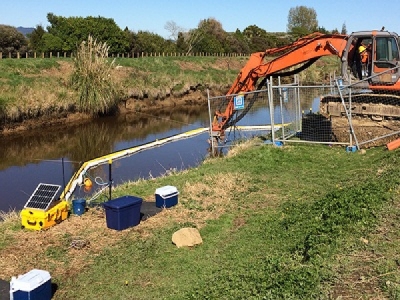
Posted on December 20, 2016
A consortium headed by EnviroWaste Services Limited has been awarded the contract for the removal of dioxin contaminated sediment from a 5.1km section of the Kopeopeo Canal near Whakatane.
EnviroWaste will lead the contract and will be supported by a range of technical and specialist companies, with civil works carried out by local company Waiotahi Contractors.
A variation to the consent was granted last month to allow contaminated sediment to be removed using a cutter-suction dredge and transferred by pipeline to the containment sites.
The method was changed after the community pointed out the risks involved in transporting partially dewatered possibly poisonous, sediment to containment sites by truck, which was the originally consented method.
With the consent in place and the contract awarded, Project Manager, Brendon Love, says the community can expect to see work begin in the near future.
The project team are very confident in this team’s ability to deliver the physical works following their involvement in the dredging trial carried out last year.
The Kopeopeo Canal Remediation project, is co-funded by the Ministry for the Environment through the Contaminated Sites Remediation Fund. It will use a staged approach to remove, safely store and treat up to 40,000m3 of dioxin contaminated sediment from the Canal.
“There will be a period of a few weeks while the contractor makes sure that all the paperwork is in place,” says Brendon. “There are significant conditions attached to the consent to cover monitoring, flood management, site management and final design documentation prior to construction.
“So it will take a bit of time for EnviroWaste to ensure they have all the necessary plans and procedures in place before construction starts. But we expect to be able to start building a containment cell in January and then start dredging the first of the sediment out of the Canal in the first quarter of 2017.
“It has been a significant process to date and I would like to thank in particular the Community Liaison Group and the Piripai Lands Trust, on whose land the first containment site will be constructed under the new methodology,” says Brendon.
“We have been talking about this project on paper for years now. I know that there was some community concern with the old method and while it has taken a considerable effort to trial a new method and vary the consents, I believe that hard work is finally paying off. We now have a method that meets both the project and community needs and finally we can start to see this contamination taken out of our Canal and safely stored and treated.”
Auckland-based EnviroWaste, has significant experience in contaminated site remediation and large scale dredging contracts, which are both key aspects of the Canal remediation project. EnviroWaste has a proven track record in completing remediation projects on time, within budget, and most importantly safely.
EnviroWaste Services General Manager Technical Services, Wayne Plummer, says it is a significant and complex project.
“It is exciting to be involved in a project which will have such a positive outcome for the community. We appreciate that the level of community interest will be high and we are open to talking through what we are doing at each stage,” says Wayne.
“We are presenting at the next Community Liaison Group meeting to explain what we will be doing and how each stage of the project will work. I expect it will be a good opportunity for people to ask questions and learn how this project be undertaken in real life.”
The next meeting is scheduled for February 2017.
The Kopeopeo Canal was contaminated between the 1950s and late 1980s as a result of stormwater discharges from a former sawmill, which treated timber using Pentachlorophenol (PCP). While unknown at the time, PCP imported into New Zealand for use in the timber processing industry also included a percentage of impurities that contained dioxins.
The project will take a staged approach to remove, safely store and treat up to 40,000m3 of sediment.
Consent was granted for works to begin in 2014, subject to significant conditions. The community raised a number of concerns about the original methodology (excavators and trucks) for removal of the sediment. Following a successful pilot study of a new method in October 2015, an application was lodged in May 2016 to vary the existing consent so that the sediment could be removed by a cutter suction dredge and transferred by pipeline to the containment sites. This new method virtually eliminates the heavy traffic and potential for spillages and associated dust generation, and brings improvements to the containment site design which reduces potential groundwater and flooding related effects.
The estimated cost of the project is $10.8 million and is equally funded by the Ministry for the Environment through the Contaminated Sites Remediation Fund and Bay of Plenty Regional Council.
Source: sunlive





